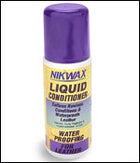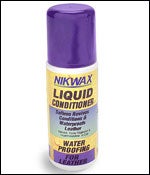Im not exactly sure what you used on the bootNikwax Waterproof Wax in a tube? If so, then its true that you probably reduced the boots breathability a little. The same could be said if you had used the classic boot waterproofer, Sno-Seal ($5 a can, and the product that has been available at REI longer than anything elseit dates back to the 1930s).
Nikwax Liquid Conditioner
 Nikwax Liquid Conditioner
Nikwax Liquid ConditionerBut has any real harm been done? No. The mineral wax in Nikwax Waterproof, derived from petroleum, doesnt soak too deeply into leather (unlike greases such as mink oil, which should never be used on modern leather boots because they soften the leather). In fact, it pretty much sits on the surface and will wear off moderately quickly. Thats pretty much true of any wax-based waterproofer, which includes Nikwax products and Sno-Seal (which uses beeswax). Silicon waterproofers also rub off after several wearings of the boot, depending on where youre hiking.
So, no worries. In a few months, the Nikwax will be gone. The general drill on good boot care is as follows: Clean dirty boots with water and a soft brush (which helps remove grit from around stitching). Rinse the inside of the boot to remove salty sweat, which is corrosive. Towel the boots off, then let them air dry for a day or two (dont bake them in hot sun or next to a dryer; room temperature is best). If the boots are old and the leather is a little dry, you can use a leather conditioner such as Nikwax Liquid Conditioner ($8; www.nikwax-usa.com), which also adds some waterproofing. Or you can go straight to the waterproof step, using the Nikwax Waterproof Wax, Nikwax Aqueous ($8), or a silicon-based waterproofer such as Tectron Extreme ($6; www.rei.com).
Youve seen our picks for 2006 Gear of the Year, and now the entire is online. Check out this years more than 400 must-have gear items, including .


